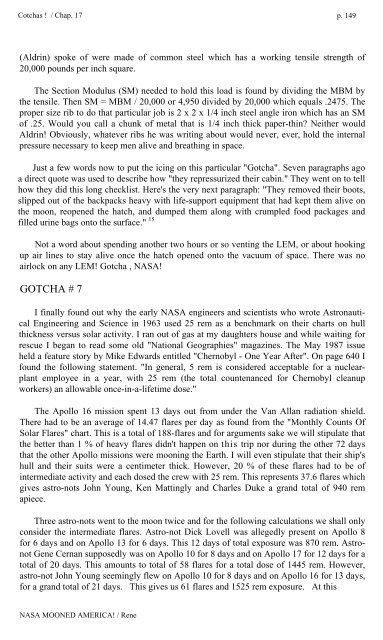Rene-NASA-Mooned-America
Rene-NASA-Mooned-America
Rene-NASA-Mooned-America
You also want an ePaper? Increase the reach of your titles
YUMPU automatically turns print PDFs into web optimized ePapers that Google loves.
Cotchas ! / Chap. 17 p. 149<br />
(Aldrin) spoke of were made of common steel which has a working tensile strength of<br />
20,000 pounds per inch square.<br />
The Section Modulus (SM) needed to hold this load is found by dividing the MBM by<br />
the tensile. Then SM = MBM / 20,000 or 4,950 divided by 20,000 which equals .2475. The<br />
proper size rib to do that particular job is 2 x 2 x 1/4 inch steel angle iron which has an SM<br />
of .25. Would you call a chunk of metal that is 1/4 inch thick paper-thin Neither would<br />
Aldrin! Obviously, whatever ribs he was writing about would never, ever, hold the internal<br />
pressure necessary to keep men alive and breathing in space.<br />
Just a few words now to put the icing on this particular "Gotcha". Seven paragraphs ago<br />
a direct quote was used to describe how "they repressurized their cabin." They went on to tell<br />
how they did this long checklist. Here's the very next paragraph: "They removed their boots,<br />
slipped out of the backpacks heavy with life-support equipment that had kept them alive on<br />
the moon, reopened the hatch, and dumped them along with crumpled food packages and<br />
filled urine bags onto the surface." 15<br />
Not a word about spending another two hours or so venting the LEM, or about hooking<br />
up air lines to stay alive once the hatch opened onto the vacuum of space. There was no<br />
airlock on any LEM! Gotcha , <strong>NASA</strong>!<br />
GOTCHA # 7<br />
I finally found out why the early <strong>NASA</strong> engineers and scientists who wrote Astronautical<br />
Engineering and Science in 1963 used 25 rem as a benchmark on their charts on hull<br />
thickness versus solar activity. I ran out of gas at my daughters house and while waiting for<br />
rescue I began to read some old "National Geographies" magazines. The May 1987 issue<br />
held a feature story by Mike Edwards entitled "Chernobyl - One Year After". On page 640 I<br />
found the following statement. "In general, 5 rem is considered acceptable for a nuclearplant<br />
employee in a year, with 25 rem (the total countenanced for Chernobyl cleanup<br />
workers) an allowable once-in-a-lifetime dose."<br />
The Apollo 16 mission spent 13 days out from under the Van Allan radiation shield.<br />
There had to be an average of 14.47 flares per day as found from the "Monthly Counts Of<br />
Solar Flares" chart. This is a total of 188-flares and for arguments sake we will stipulate that<br />
the better than 1 % of heavy flares didn't happen on this trip nor during the other 72 days<br />
that the other Apollo missions were mooning the Earth. I will even stipulate that their ship's<br />
hull and their suits were a centimeter thick. However, 20 % of these flares had to be of<br />
intermediate activity and each dosed the crew with 25 rem. This represents 37.6 flares which<br />
gives astro-nots John Young, Ken Mattingly and Charles Duke a grand total of 940 rem<br />
apiece.<br />
Three astro-nots went to the moon twice and for the following calculations we shall only<br />
consider the intermediate flares. Astro-not Dick Lovell was allegedly present on Apollo 8<br />
for 6 days and on Apollo 13 for 6 days. This 12 days of total exposure was 870 rem. Astronot<br />
Gene Cernan supposedly was on Apollo 10 for 8 days and on Apollo 17 for 12 days for a<br />
total of 20 days. This amounts to total of 58 flares for a total dose of 1445 rem. However,<br />
astro-not John Young seemingly flew on Apollo 10 for 8 days and on Apollo 16 for 13 days,<br />
for a grand total of 21 days. This gives us 61 flares and 1525 rem exposure. At this<br />
<strong>NASA</strong> MOONED AMERICA! / <strong>Rene</strong>


